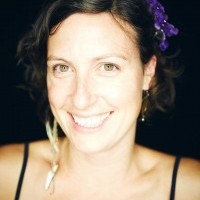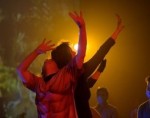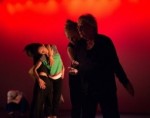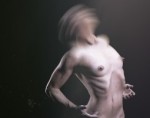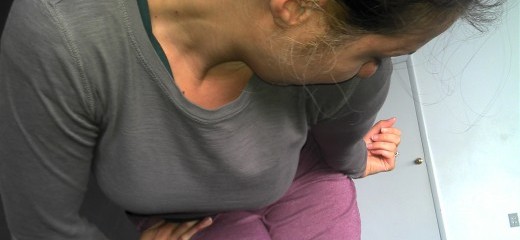
From the Studio: Experimentation and Process
By Megan Bridge
For four months this past winter and spring I met on a regular basis with a small group of artists to create a new work. We gathered for 3 or 4 hours, once or twice a week. We warmed up our bodies while chatting about our personal lives and getting to know new things about each other. We engaged in rigorous dialogue around a proposed set of ideas, and then tried things. Lots and lots of things....things that looked like the most traditional kind of dance you could imagine and things that were so, so stupid. Things that were magical, things that took wild leaps of faith in each other, things that were terrible failures, risky things, safe and comfy things. In the end we had around 50 minutes of material that we shared with audiences. Also in the end I really, truly believe that we could have chosen completely different things to place into our collection of materials and the same transaction would have occurred, which is that we built trust, and a shared sense of aesthetics around a certain set of ideas. We “moved in” together, into this house of ideas we constructed. We tore down walls, we built new ones, we kept falling through the floor in places where we hadn’t shored it up enough. But there we were. Together.Our spontaneous community developed in a certain time (2012) and place (a warehouse in Kensington, Philadelphia) around a set of proposed ideas. I’m writing to report on a set of findings from the studio. I call my work both “experimental” and “process based.” Being in the studio allows me to confront those monikers and try to figure out what they mean.
Major granddaddies of art in the 20th century, John Cage and Marcel Duchamp, have insights that are relevant here. Cage defines an experiment as something where the outcome is unknown. Duchamp’s idea of art is that it is a transaction...what the artist by doing begins, the audience by viewing completes. Process art lengthens the time of this transaction.The art trickles out of the “event” or “gallery” setting and seeps into life. With process art we take it with us more, because the art isn’t just happening during the time when we’re there viewing it. Artists who make process-based, experimental work, and audiences who are interested in this kind of work, enter into a cultural transaction without knowing what the outcome might be.
Process Art: I picture slowly melting wax sculptures in a gallery, a public art installation slowly decaying under the force of the elements, group rituals involving animal guts in a castle outside Vienna. In “process-based” dance or choreography, the imagery is more mundane. To me making work that is process-based simply means that the production phase, and the time that the work lives in front of an audience, doesn’t constitute the whole of “the work” (this is a good thing, because in dance the performance run can be painfully short). So...if “the show” isn’t “the work,” then what is? For me “the work” is the research that I do late at night, following ideas to illogical conclusions, to dead ends, and to twists in the road that make me realize I’m making a piece about something completely different than I thought. “The work” is being part of the shared culture that evolves around each new creative project--a particular group of people living through a shared set of physical, intellectual, and creative proposals for a certain period of time. “The work” is being in a space of openness to my environment, following a different kind of logic, one that reveals itself slowly, and only through careful attention and curiosity.
Some artists call their work their religion. Maybe they say it as if they’re joking, or apologizing, but there’s something worth investigating more closely here. Process art has been linked to indigenous rites and religious rituals. This kind of art is not at all about what we can see or look at--more important is what’s happening over time, whether the “happening” is seen, heard, smelt, felt, sensed, or imagined. This is familiar territory to the field of performance studies. In particular I’m thinking about anthropologist Victor Turner’s ideas on ritual, theater, and play. As far back as 1965 theater director Richard Schechner (who collaborated with Turner) argued, “performance is an inclusive category that includes play, games, sports, performance in everyday life, and ritual.”* For Schechner and Turner (me, too!) the act of performance creates a shared liminal space for both artists and audience members. It’s a ritual space, outside of our mundane concerns. It’s a place to wonder together.
My collaborators and I tried to let audiences into our performance by creating and unfolding an immersive experience, a little trip for us all to take together. The attention we invited was casual, more like being in a gallery than a theater. This kind of attention is strange, unfamiliar for dance audiences, which was strange for us. There was so much serious “watching” going on. But we weren’t interested in “communicating” or “expressing” something. We were more interested in sharing an experience with folks who were open to it. Asking some questions. Musing together in a fourth-story converted loft.
What’s the point of all this? For me the most important part of the work is to make and question lots of things. Think differently. Seek out multiple points of view. TV, media, and the popular culture industry reinforce narrow value systems. Art proposes new ones. As my collaborators and I go on to other creative projects with other collaborators we will, without even realizing it, populate new communities with the ideas and aesthetic values that sprung up in a Kensington warehouse over the course of this particular experimental creative process.
By Megan Bridge
June 14, 2012

